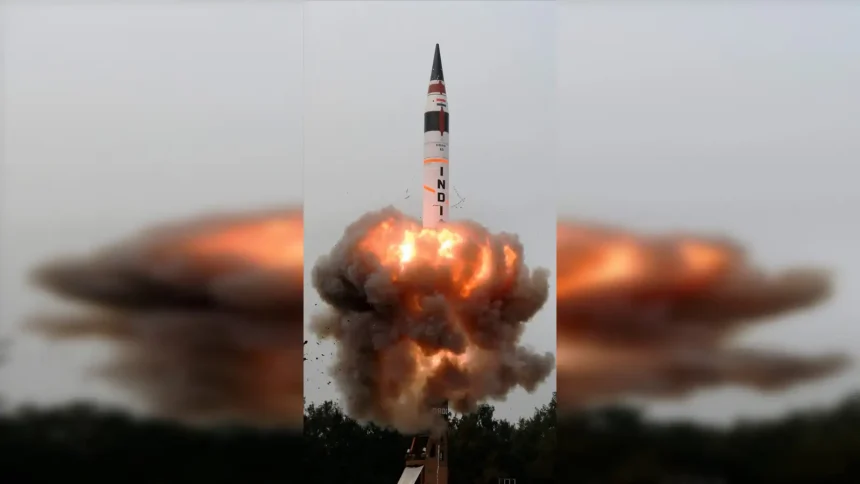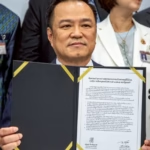NEW DELHI – India carried out a successful test of its Agni-5 missile on August 20, 2025, at the Integrated Test Range in Chandipur, Odisha. Overseen by the Strategic Forces Command, this test confirmed the missile’s operational and technical standards, supported India’s status as a nuclear force, and highlighted its reach.
With a range of over 5,000 kilometres, Agni-5 can hit most locations in Asia, covering all of Pakistan as well as northern China. This achievement strengthens India’s position in regional defence.
Developed by the Defence Research and Development Organization (DRDO), Agni-5 is a three-stage, solid-fuel missile that can be fired from a canister. The missile uses advanced navigation, guidance, and propulsion systems.
It is also built with Multiple Independently Targetable Re-entry Vehicle (MIRV) technology, first tested on March 11, 2024. This lets Agni-5 carry and deliver several nuclear warheads to different locations in a single launch.
After the launch, Prime Minister Narendra Modi publicly praised the DRDO team for progress in India’s missile capability.
India’s Nuclear Policy and Deterrence
India’s nuclear approach is guided by the principles of ‘credible minimum deterrence’ and a ‘No First Use’ policy. Since its first nuclear test in 1974 and those in 1998, India has steadily improved its arsenal.
Agni-5, able to carry up to three nuclear warheads, plays a key role alongside other Agni missiles (Agni-1 to Agni-4, with ranges from 700 to 3,500 kilometres), which are already in use. The canister-based design of Agni-5 makes it easier to move and launch quickly from different terrains.
Figures from the Stockholm International Peace Research Institute (SIPRI) show India has around 180 nuclear warheads. This is slightly ahead of Pakistan’s 170 but trails China’s 600, which could rise to 1,500 by 2035. India’s nuclear forces, known as a triad, include land-based missiles, air-dropped weapons, and sea-operating platforms.
The INS Arihant and INS Arighaat, with another vessel (INS Aridhaman) expected soon, form the core of India’s nuclear submarine fleet. India is also developing the Agni-Prime, with ranges of 1,000 to 2,000 kilometres, to replace older models.
Agni-5’s recent test highlights Indian advances in missile technology and keeps its second-strike ability strong. DRDO officials say this shows India’s self-sufficiency in defence and a focus on national security. The missile’s locally-made electronics and high-precision sensors help it reach targets with great accuracy.
Relations with China and Pakistan
India’s military stance is shaped by ongoing disputes with both China and Pakistan. Agni-5’s reach, said by some Chinese experts to be as much as 8,000 kilometres, puts major Chinese cities within range. This has attracted attention in Beijing, especially since tensions rose after the 2020 border clash in Ladakh and later incidents in Arunachal Pradesh in 2022.
India’s role in the Quad partnership (with the US, Australia, and Japan) has caused concern in China, which views this as a challenge to its influence. The timing of the Agni-5 test, ahead of Prime Minister Modi’s planned visit to Beijing, has led some to see it as a strategic message. Still, India’s Defence Ministry repeats that its missile tests do not target specific countries.
The history with Pakistan is marked by conflict since 1947, with several wars fought over the years. Tensions rose again in May 2025 after a deadly attack in Kashmir that India blamed on Pakistan.
Agni-5 gives India the ability to strike anywhere in Pakistan, with shorter-range missiles like Prithvi-II and Agni-1 covering anything closer. Indian leaders have called the latest test a routine drill, despite recent conflict.
China’s state-run outlets, such as Global Times, have played down Agni-5, arguing it is not a real threat and accusing Western powers of ignoring India’s missile activities.
Chinese officials refer to a UN resolution asking India and Pakistan to halt missile development, even though it is non-binding. Some Chinese analysts admit the missile’s actual reach may be higher than India claims.
The United States Urges Restraint
Pakistan’s response has been calm. Officials confirmed they were notified in advance, as required under an agreement with India. Still, Pakistan is anxious about falling behind as India’s MIRV technology allows fewer missiles to hit more targets.
While Pakistan’s missiles, like the Ababeel and Shaheen-1A, offer some balance, they are held back by limited resources.
The Agni-5 test has sparked talks about the effects on safety and balance in the region. Observers believe that while it is a planned exercise, testing the missile at a time of disputes with China and Pakistan sends a clear message. The missile’s wide range fits India’s larger plan to meet China’s military moves, including its ambitions for more aircraft carriers.
Yet, there are growing worries around crisis stability. The Federation of American Scientists warns that India’s MIRV-equipped missiles may increase the chance of escalation with Pakistan. Experts say that although India and Pakistan are unlikely to use nuclear weapons unless forced, high tensions bring risks.
Globally, the United States urges restraint among countries with nuclear capability, while praising India’s record on non-proliferation. India’s push to join the Missile Technology Control Regime shows its efforts to fit with global norms, even though there are no strict bans on its missile work.
The Agni-5 test is a clear signal of India’s push for strong defence and self-reliance. As DRDO works on longer-range versions and new features like bunker-buster warheads, India is closing the gap with major powers. This test shows India’s focus on protecting its sovereignty while dealing with tricky diplomacy, including future talks with China.
Agni-5 now stands out as a sign of India’s advanced military abilities. A DRDO scientist summed it up, saying the Agni-5 is more than hardware; it serves as a shield for the country.
With its nuclear launch options growing and newer missiles in the pipeline, India is set to hold a firmer place in both regional and global security conversations, all while aiming to keep peace in South Asia.














